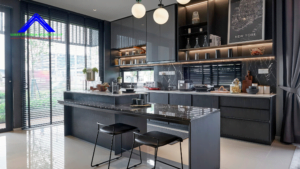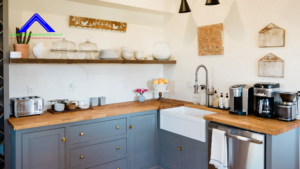Welcome to the heart of your home – the kitchen. At Shree Interior Wedtech, we believe that the kitchen is more than just a space for cooking; it’s a reflection of your lifestyle and culinary passion. In this ultimate guide, we’ll explore the art of designing a modular kitchen in Navi Mumbai that combines functionality, style, and innovation.
1. Understanding Modular Kitchens:

Modular kitchens are a modern solution that offers flexibility, organization, and efficiency. Comprising pre-designed units or modules, these kitchens allow for customization according to individual needs and space constraints.
2. Assessing Your Needs:

The first step in designing a modular kitchen is to assess your requirements. Consider factors such as cooking habits, storage needs, family size, and available space. This will help determine the layout and configuration of your kitchen.
3. Choosing the Right Layout:

Modular kitchens offer various layouts, including L-shaped, U-shaped, galley, and island kitchens. Select a layout that optimizes space utilization and workflow, ensuring convenience and efficiency in your daily cooking activities.
4. Selecting Materials and Finishes:
Pay attention to the materials and finishes used in your modular kitchen. Opt for durable and easy-to-maintain materials such as stainless steel, laminate, acrylic, or PVC for cabinets, countertops, and backsplashes. Choose finishes that complement your overall design theme.
5. Maximizing Storage Solutions:
One of the key advantages of modular kitchens is their efficient storage solutions. Incorporate cabinets, drawers, pull-out trays, and corner units to maximize storage capacity and organization. Customize storage options based on your specific needs, such as for pots and pans, spices, or utensils.
6. Integrating Appliances:
Plan the placement of appliances strategically to optimize workflow and accessibility. Consider built-in or integrated appliances such as ovens, microwaves, dishwashers, and refrigerators to maintain a streamlined and cohesive look in your kitchen.
7. Adding Functional Accessories:
Enhance the functionality of your modular kitchen with thoughtful accessories and fittings. Include features like soft-close drawers, pull-out baskets, carousel units, and built-in organizers to simplify kitchen tasks and improve efficiency.
8. Incorporating Lighting:
Proper lighting is essential in a modular kitchen to ensure visibility and ambiance. Combine natural light with artificial lighting sources such as overhead fixtures, task lighting, and under-cabinet lights to illuminate work areas effectively.
9. Personalizing the Design:
Infuse your personality and style into the design of your modular kitchen. Experiment with colors, textures, and decorative elements to create a space that reflects your taste and enhances your cooking experience.


%20(1).png)
.png)
No comments:
Post a Comment